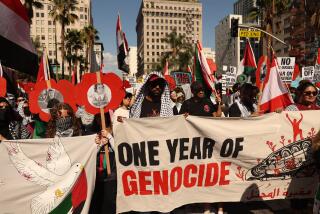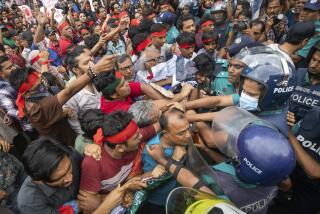Egypt protesters try a scattered approach
- Share via
CAIRO — As Friday’s march took a left down a trash-filled street, Enas Mohammad broke off from fellow protesters to argue with a woman standing in front of a poultry shop.
Mohammad’s already high-pitched voice peaked as she almost shrieked about having seen bodies in the street after the military and police cracked down on Muslim Brotherhood supporters demonstrating against Egypt’s July 3 military coup. But the woman seemed unconvinced, one of many who have sided with the military against the backers of deposed Islamist President Mohamed Morsi.
“I’m trying to explain to them what they aren’t seeing. They are only watching state media — I was in Ramses, I saw the dead bodies,” said Mohammad, a homemaker from the impoverished Sharabia neighborhood. “So they can understand we didn’t do anything wrong.”
A week after Egypt witnessed its bloodiest days of unrest, protesters against the military-backed government came out across Cairo and outlying provinces amid continued tight security. This week, though, relative calm prevailed. One protester was reported killed when security forces attacked.
Protest organizers took a different tack this time: Rather than gathering in one location, groups of demonstrators marched through their respective neighborhoods. More than two dozen separate protests were reported in Cairo, with others elsewhere in the country.
The strategy left them less vulnerable to attack by security forces and allowed them to take their message to the doorsteps of neighbors who they worry might have misperceptions about them.
In Sharabia, female protesters opened their purses to show they had no weapons. And each time they marched past a church, they pointed out how none of them had done the Christian house of worship any harm.
The gatherings, dubbed the Friday of Martyrs, were less about reinstating Morsi than about opposing Gen. Abdel Fattah Sisi, the head of the armed forces, whose violent crackdown on dissent has resulted in more than 900 deaths.
The protesters walked for hours through narrow, winding and muddy streets lined with piles of rotting garbage. Residents leaned over their balconies and out their doors to watch. Some yelled at the marchers; others lifted cellphones to record them.
On this Muslim day of prayer, some men sat on the street in plastic chairs, smoking hookah and drinking tea, only to find themselves suddenly surrounded by chanting men, women and children.
“This is for us to cover all the streets, and not just Rabaa and Nahda,” said Rasha Iman, referring to the two squares where protesters were encamped for six weeks before being bloodily ousted by security forces. “We are here showing them that we are still here.”
As they walked on, a little boy playing with toy knives waved them faux-threateningly at the marchers.
Mohammad Ali, an engineer, approached the boy and gave him a juice box. The boy at first was hesitant, but Ali insisted.
“He’s a kid; he will pray like his father prays and do like his father does,” Ali explained. “Our goal is to deliver a message, street by street and neighborhood by neighborhood so we can say we are your brothers, not terrorists.”
Nabil Hamid, a resident of the neighborhood, stood on the sidewalk watching them pass. He didn’t think they were terrorists and even recognized some as neighbors, whom he described as “respectable.”
But Hamid hasn’t had steady work since the protests began many weeks ago, and he blamed them for that.
“Most of the people want the country to stabilize and to move on with its work,” Hamid said, standing in front of a shuttered sunglass shop. “We are not against them, but we are against the country being at a standstill.”
More to Read
Sign up for Essential California
The most important California stories and recommendations in your inbox every morning.
You may occasionally receive promotional content from the Los Angeles Times.














